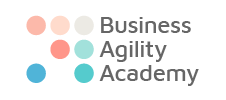Learning Objectives
Introduction
The goal of this set of learning objectives is to provide an overview of agile leadership and how to move towards becoming one. It also covers the vital topic of culture, and how leaders can consciously shape a culture compatible with business agility and innovation. It is agnostic and, thus, is not specific to any particular approach or framework. Instead, it aims to be principles-based and, therefore, applicable to multiple organizational contexts.
Course Format
The course can be taught in multiple formats, and we encourage educators to create an offering that is most suited to their client’s needs.. It can be a live instructor-led class, self-paced online, or hybrid. It is up to educators to ensure that the learning objectives are met by every student. In order to maintain quality, we will gather feedback from every student. Suggested learning time, 16 hours.
Course Delivery
This class may be designed and delivered by any approved educator holding the E-BAC credential.
Course Prerequisites
None.
Licensing Information
These learning objectives were created by Karim Harbott and Sohrab Salimi for the Business Agility Association. This work is licensed under the Creative Commons Attribution-NonCommercial-NoDerivatives 4.0 International License. To view a copy of this license, visit http://creativecommons.org/licenses/by-nc-nd/4.0/.
Learning Objectives
1 – The What and Why of Agile Leadership
The intent of this learning objective is to outline the need for leadership styles to evolve beyond scope of the 20th-century, Industrial Revolution models of maximizing efficiency and towards leading for innovation, creativity and engagement.
- Outline the work of at least two early management pioneers and explain how their approaches were suited to the nature of the work being done during the late 19th and early 20th centuries.
- Describe the limitations of traditional management techniques in a climate of an increased pace of change, greater interconnectedness and growing complexity of the work.
- Compare agile leadership with traditional leadership and explain the benefits of agile leadership when undertaking complex work with high uncertainty and volatility.
- Describe at least one established leadership development model which is highly compatible with agile leadership.
2 – The Agile Leadership Mindset
The intent of this learning objective is to create insights into the mindset changes required for 21st-century agile leadership.
- Explain the importance of organizational transformations beginning with leaders undergoing a journey of self-discovery and growth.
- Outline how the mindset of agile leaders differs from that of more traditional leaders.
- Describe at least one technique to increase self awareness as a leader and to identify opportunities for growth.
- List at least four leadership attributes which align with agility.
- Reflect on how one’s own mental models impact behavior and outcomes.
3 – Shaping an Agile Culture
The intent of this learning objective is to enable participants to connect to what organizational culture is so that they actively shape it to support greater agility and business outcomes.
- Explain the importance of organizational culture and describe the impact it can have on organizational outcomes.
- Outline at least one framework for mapping organizational culture.
- Assess the compatibility of various culture types with business agility, and the implications for approaching a transformation.
- List at least three factors, which can be directly controlled by leaders, and which can influence and shape the culture of an organization.
- Explain the significance of employee engagement in organizations and state at least three techniques for increasing it.
4 – Leading High-Performing, Self-Managing Teams
The intent of this learning objective is to explore how to create the environment for high-performing, self-managing, collaborative teams.
- Outline the key advantages of cross-functional teams.
- Explain the challenges of traditional, manager-led teams when undertaking complex, dynamic work.
- List at least three necessary conditions for decentralizing decision-making.
- Describe at least two techniques for building trust and psychological safety within teams.
- Summarize the benefits of neurodiversity on a team, and outline at least one technique for achieving it.
- Describe how leaders can create an inclusive environment within teams.
5 – People Development
The intent of this learning objective is to connect leaders with the need to systematically grow the capability of people in their organization.
- Outline the key challenges with traditional approaches to developing people in organizations.
- Describe the importance of leaders taking an active role in the development of people.
- Explain the benefits of a growth mindset when leading people.
- Explain a technique for helping people to identify and build on their passions, interests, and strengths.
- Outline how leaders can encourage the co-creation of people’s development paths.
- Describe at least one technique for setting, and working towards goals that provides greater flexibility and ownership than traditional approaches.
- Demonstrate at least one technique for giving constructive feedback.
6 – Leading with Purpose & Values
The intent of this learning objective is to demonstrate authenticity by aligning one’s actions with the organizational purpose and values.
- Co-create and communicate and communicate a compelling organizational purpose.
- Co-create and communicate organizational core values
- Describe at least 3 techniques for embedding organizational purpose and values into everyday decision-making.
- Explain the importance of understanding one’s personal purpose and values in order to lead with authenticity.
- Demonstrate storytelling as a device for inspiring, informing, and aligning people in the organization.

